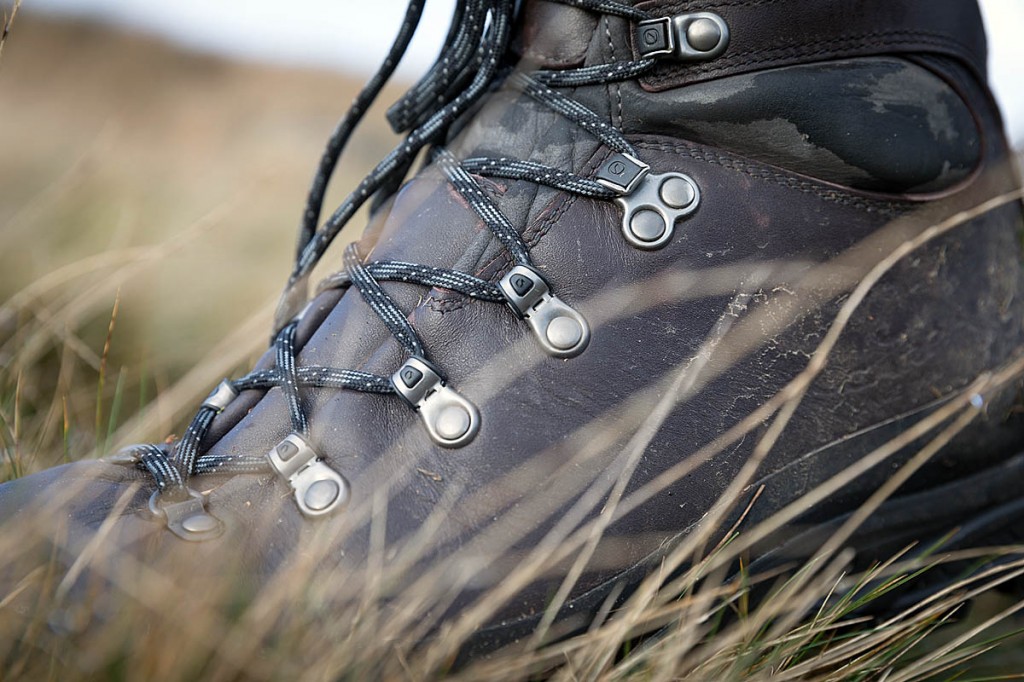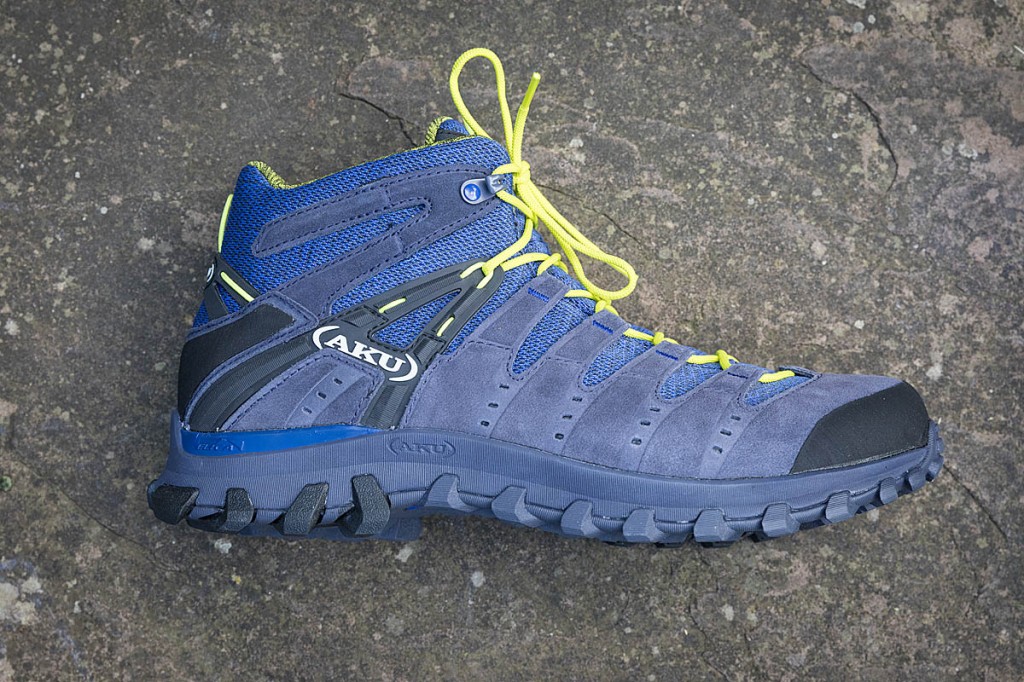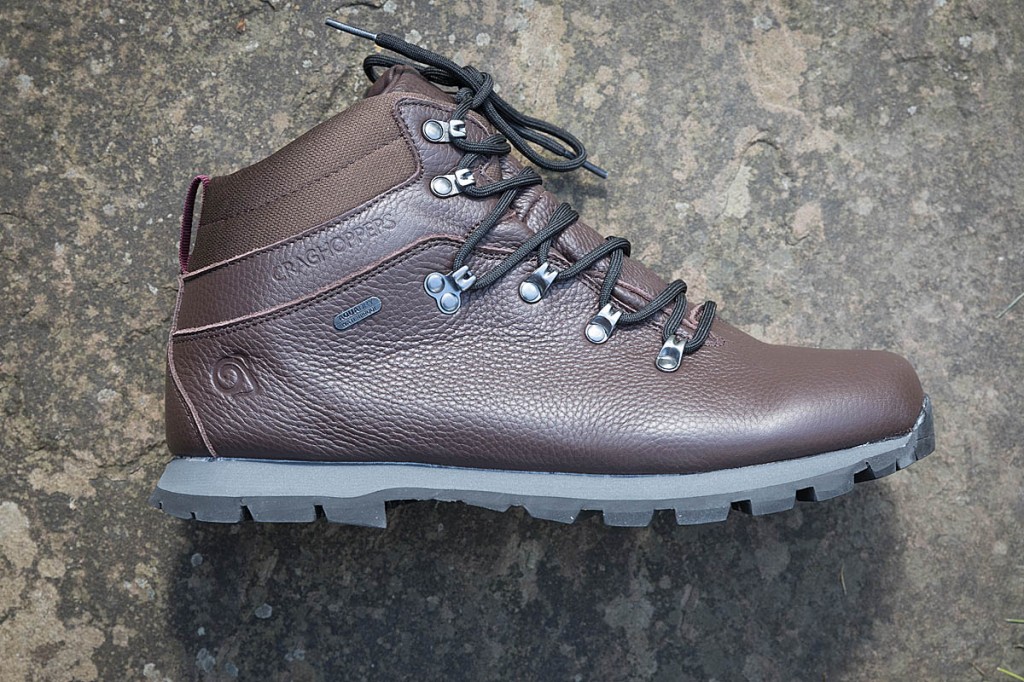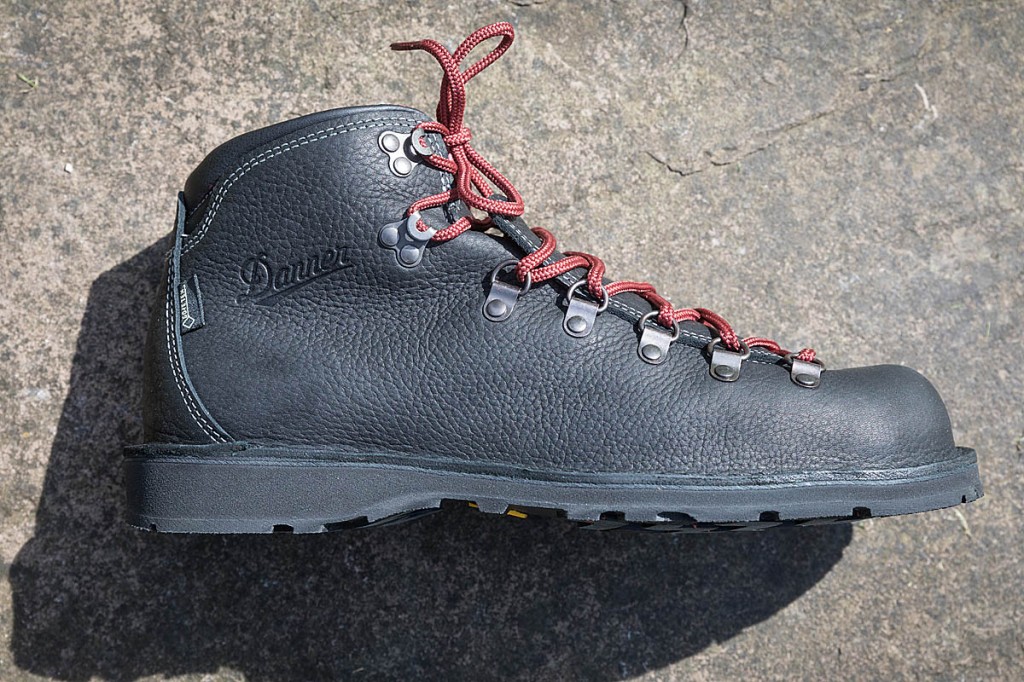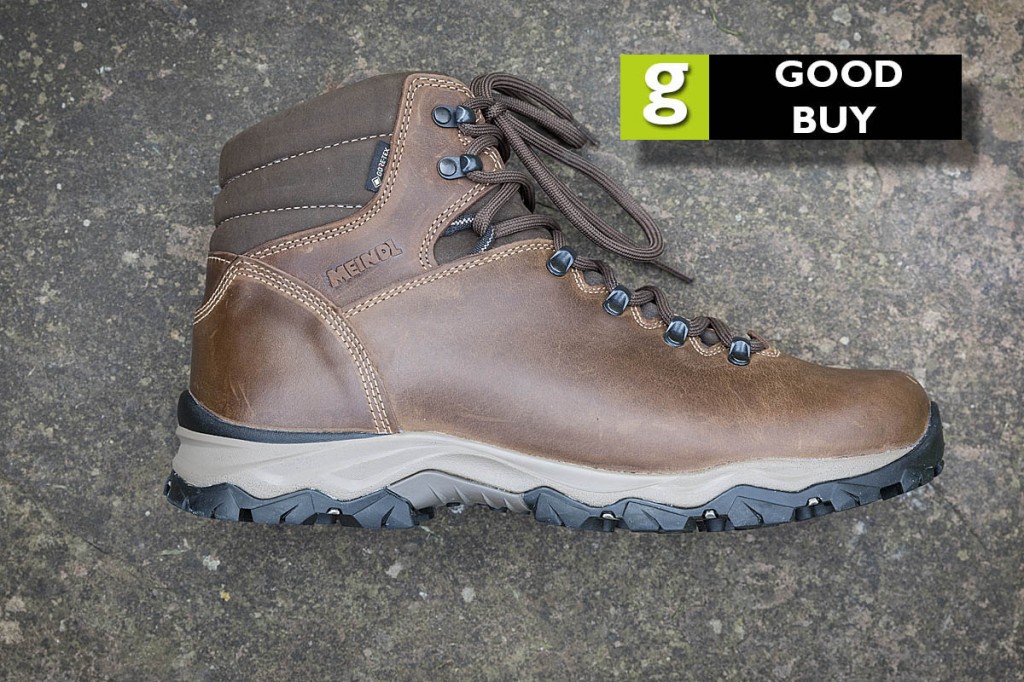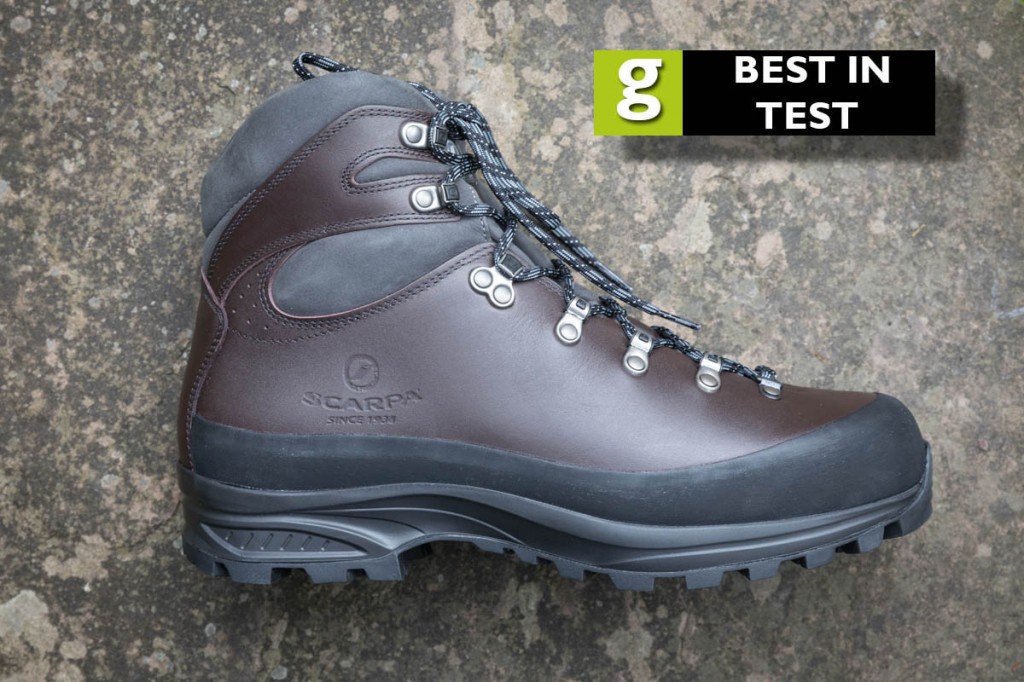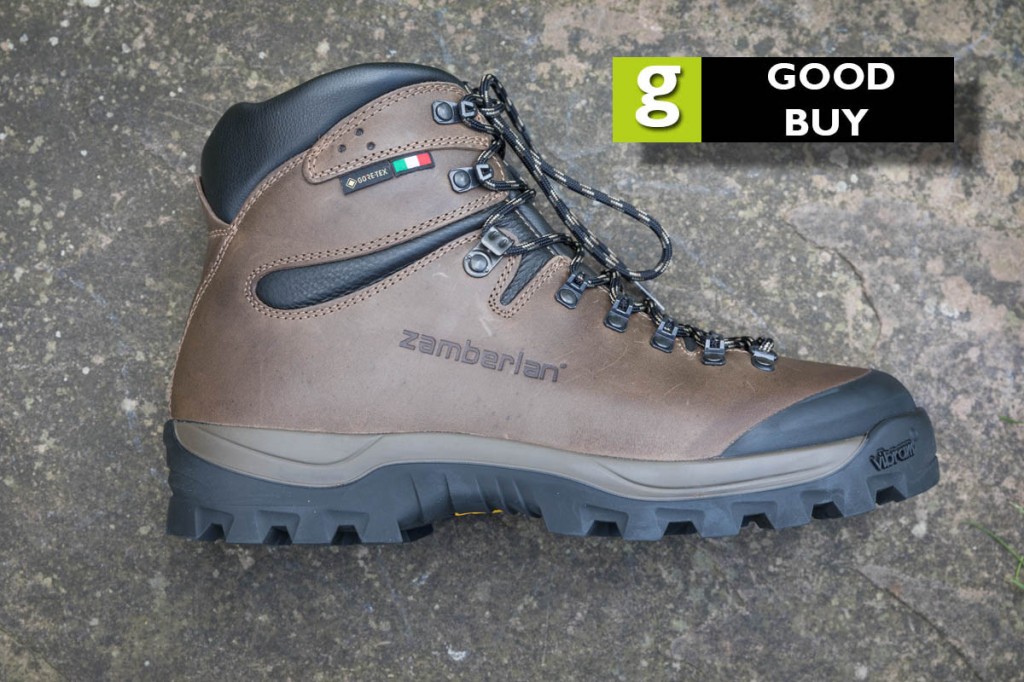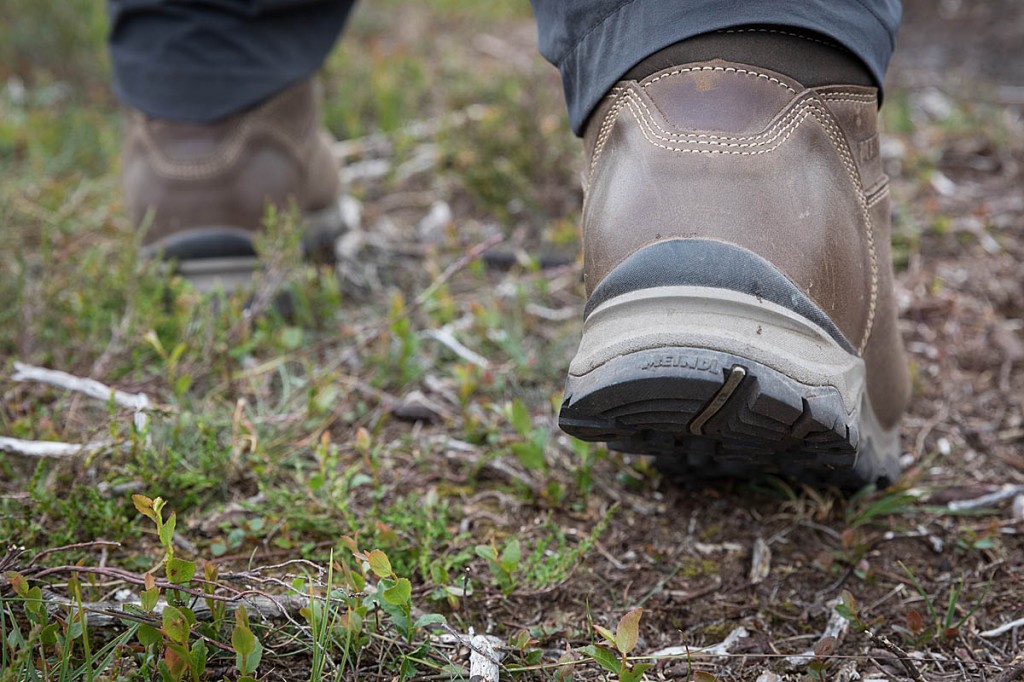First, it’s useful to explain what we mean by a three- to four-season boot. We’ve seen from time to time this term used to mean a boot that suitable for use in full winter conditions, as well as walking during the rest of the year. But our definition for this test is for a boot that can be used throughout the year, but not in the kind of conditions you’ll encounter on UK mountains during a true winter spell.
For this, we’ve taken full winter conditions to mean mountain terrain that has been subject to sub-zero temperatures and where you’re likely to encounter ice, hard snow, including névé, and where you should be wearing crampons and carrying an ice-axe.
In these conditions, we believe you should be pulling on a pair of true winter boots, with soles stiff enough to enable crampons to be fitted and steps to be kicked into hard snow. It’s very difficult to design a boot that will do that job while being suitable for walking in more temperate months, and only one of the boots in our test can safely be used with walking crampons.
So we asked brands to supply us with boots suitable for use on UK or European hills and mountains in situations short of full winter conditions.
The six brands’ footwear was tested extensively in varying conditions, ranging from warm, dry days to torrential wet periods and cold days.
People’s feet vary markedly and a boot that suited the tester is not necessarily going to be right for everyone. For that reason, we always recommend trying on boots before buying. A good outdoors retailer will ensure you’re supplied with a model and size that fits your feet.
The tester for this review has size 9½ (Eur 44) feet with a broad forefoot and low volume foot.
We’ve also now included in our ratings a score for sustainability, based on the brands’ statements on the policies and actions they have put in place to contribute to lessening the environmental impact of the particular model and other products in their ranges.
None of the boots tested was suitable for vegans.
AKU Alterra Lite Mid GTX
Price: £169.90
Colour: blue
Weight: 1,022g/pair
Construction: suede/Air8000 synthetic
Waterproofing: Gore-Tex Extended Comfort
Country of manufacture: Vietnam
Sole stiffness: 6
Women’s version: yes
Sizes: women’s 3-9; men’s 6-13
Crampon compatible: no
The AKU boots are the lightest in the test, which makes them mostly suitable for use in less arduous conditions typically found during spring, summer and autumn.
The Alterra Lite Mid GTX can also be used for occasional forays into more technical terrain as conditions worsen, but are definitely aimed at walking below the snowline. The sole unit is a little stiffer than typical summer walking boots and there’s good protection at the toe and heel thanks to hard rubber overlays in those area.
The uppers combine suede elements with the brand’s Air8000 synthetic material in the forefoot, tongue and ankle cuff. The ankle isn’t very high in this mid-design boot, which helps an unrestricted movement of the leg during walking.
The lacing operates through four pairs of suede loops and a rubberised loop then a single pair of metal locking hooks. The rubberised loop features a thin fabric cord that then extends over the top of the heel area to help keep things in place there.
Waterproofing comes from a Gore-Tex Extended Comfort membrane.
The boot is designed around AKU’s Elica system, which it claims help a natural stride and asymmetrical outsole lugs and midsole. AKU says this follows the natural inclination of the foot.
The uppers are supple and didn’t really need any breaking in. The forefoot is fairly wide and has medium to low volume. Generally the AKU boots were very comfortable, with good underfoot cushioning, thanks to the EVA midsole and the Ortholite hybrid partially recycled insole. For me, though, there was pressure felt on the outside of the toe area because it narrows fairly markedly around the fourth and fifth toe.
The Alterra Lite Mid GTX kept out the rain and splashes though, as with most boots with fabric areas, once this becomes soaked it feels cool, as a thin waterproof membrane is the only thing keeping the water out.
The boot uses the brand’s Tenuta sole, with its asymmetric pattern with harder lugs on the outer area of the forefoot and heel and slightly softer ones on the inner areas.
Performance of the AKU boot was good. Braking and traction on wet grass were very good. On wet rock, braking was good and traction very good.
The Alterra Lite Mid GTX is a good boot for general use in spring, summer and autumn. Its light weight makes it ideal for longer walks and it will cope with slightly technical terrain thanks to good sole stiffness and grip performance. During winter, it’s less suitable, with softer uppers not suitable for, say, kicking steps in snow and it certainly won’t take a crampon.
So for a walker who only occasionally pulls on their boots as the temperature drops, it represents a reasonably priced all-rounder. Just stay below the snowline.
In terms of sustainability, AKU has abandoned the use of acrylic-based glues and switched to water-based formulae. It also uses cardboard for its packaging, urging users to recycle the boxes once used. The footbed is also made partly from recycled material.
Best uses: fellwalking in spring, summer and autumn, with an occasional outing in winter below the snow line; fast and light walking.
Performance 32/40
Comfort 24/30
Quality 7/10
Value for money 7/10
Sustainability 6/10
Total score: 76/100
Craghoppers Kiwi Trek
Price: £150
Colour: brown
Weight: 1,176g/pair
Construction: leather
Waterproofing: Aquadry membrane
Country of manufacture: China
Sole stiffness: 4
Women’s version: no
Sizes: 5-13
Crampon compatible: no
Craghoppers may not be the first brand you think of when it comes to walking boots, but the Kiwi Trek looks as traditional as they come.
The brown full-grain leather has a stipple-patterned surface and the tongue and ankle cuff also have leather lining.
Lacing is via three pairs of metal, loops then a set-back metal hook directed towards the heel, and finally two metal hooks to get the correct tension at the ankle area. The leather is supple and there’s a padded ankle cuff, making the Craghoppers boot very comfortable.
The toe box is stiffened to give protection in this area, and the heel cup is similarly reinforced. There’s just one stitched joint in the leather, at the inner side of the forefoot. The forefoot is quite wide and has a medium to high volume.
The Kiwi Trek has Craghoppers’ Aquadry lining to reinforce the leather’s waterproofing. The lining has the brand’s NosiLife anti-insect treatment.
The sole unit is fairly thin and there wasn’t a great deal of underfoot cushioning. The sole is fairly flexible, so not great if you’re attempting to kick steps. Most of the cushioning comes from an EVA midsole and footbed, which has good depth at the heel area.
The outsole is a Vibram unit with 5mm lugs. The heel area flares out a little to give a wider contact with the ground.
Braking and traction on wet grass was reasonable. The Kiwi Trek had fairly good braking on wet rock and good traction on wet rocky terrain.
The boots come with standard brown laces plus an extra orange pair, if you want to enliven their look.
The Craghoppers boot was the most competitively priced and second-lightest in the test, despite the leather construction. The Kiwi Trek isn’t really suitable for full winter conditions, but the light weight and good waterproofing made them a good choice for spring, summer and autumn, though they did feel warm on days when the temperature rose. They’re suitable for an occasional foray onto the mountains on winter days when the terrain isn’t frozen. They’re not stiff enough for fitting crampons.
Craghoppers is a member of the Ethical Trade Initiative. Its footwear is guaranteed for two years and the company is a member of the Higg Index to practically measure its production facilities in the supply chain to assess their environmental sustainability. For more than 10 years it has imported goods from Liverpool rather than southern ports, reducing its road miles by 400,000 miles per year.
Best uses: fellwalking in spring, summer and autumn, with an occasional outing in winter on non-frozen terrain. Year-round country walking.
Performance 27/40
Comfort 25/30
Quality 7/10
Value for money 8/10
Sustainability 6/10
Total score: 73/100
Danner Mountain Pass
Price: £370
Colour: black
Weight: 1,390g/pair
Construction: full-grain leather with 200g Thinsulate insulation
Waterproofing: Gore-Tex
Country of manufacture: USA
Sole stiffness: 5
Women’s version: yes
Sizes: women’s 3½-8; men’s 6-12
Crampon compatible: no
The Mountain Pass boots are available in either insulated or uninsulated versions.
The pair we tested were the model that has a layer of Thinsulate insulation built into the construction. The uppers are full-grain leather with a stippled patterning. The Mountain Pass boots also had a Gore-Tex waterproof membrane.
This, combined with an outsole designed to give better grip on wet ice and frozen terrain, marks the boots out as an ideal choice for when the temperature drops. However, they’re not suitable for fitting crampons – the sole is too flexible.
But in wet snow, sludge and general cool wet and boggy conditions, the Danner boots come into their own.
The uppers have a stiffened heel cup and the toe box is also hardened, giving good protection on rocky ground. Lacing is via five pairs of metal loops plus two upper pairs of metal hooks. The tongue is padded leather, as is the ankle cuff and there’s also an asymmetric leather overlapping flap on the tongue, stitched on the inner side of the foot and unattached on the outer side. When the laces are tightened, this sits over the tongue, giving extra protection.
The laces are quite short, and there’s a tendency to overtighten them at the ankle section which can induce discomfort at the tongue and cuff press into the ankle. I found careful lacing was the key to avoiding this. With the right tension, the boots were comfortable in this area.
The sole unit is unusual as it’s a ‘stitchdown’ construction, with the sole projecting about 5mm proud of the uppers all round. This gives a wider footprint for the boot, but didn’t cause any tip problems.
The outsole is a Vibram Arctic Grip model, with a lug pattern designed to give good grip on wet snow and ice. The outsole has a slight convex profile when viewed from the toe end of the boot, meaning the centre of the sole in the forefoot area strikes the ground more than the outer areas, which probably accounted for the pronounced clomping sound of the boots when negotiating rocky ground and hard trails.
The midsole is fairly soft but is quite thin at the forefoot area, providing only moderate underfoot cushioning. The Ortholite footbed has good cushioning at the heel.
The forefoot is quite wide and has medium-to-low volume. Overall, the Danner boots provided good comfort, subject to getting the ankle lacing right, and kept my feet warm and dry throughout.
Braking and traction on wet grass was very good. Braking on wet rock was less assured, but traction on wet rock was very good.
For an all-leather construction with a good outsole, the Mountain Pass was relatively light, making longer journeys in cold, wet conditions less tiring. Quality of the USA-constructed boots was very good, which is reflected in the price.
While not suitable for full mountain winter conditions, the Danner boot was able to cope with just about all other situations. It resisted rain and mud well, can cope with wet snow and slush, and will give assurance on icy trails. It’s comfortable and light enough to be an everyday boot for spring, summer and winter, though it will probably feel overwarm for hot summer days. With the proviso of not being suitable for crampon use in winter mountain walking, the Mountain Pass is also at home in typical UK wet winter conditions.
The boots come with a year’s warranty and, with the exception of the liner, can be ‘recrafted’, ie resoled, stretched and restitched. Danner supports several organisations in the USA, including a mainly African American group in its home city of Portland; volunteer trail-keepers in Oregon; a non-profit organisation promoting affordable housing across the USA; and a mountain elk conservation project.
Best uses: mountain and fellwalking; wet snow and ice walking; year-round hillwalking; urban winter walking.
Performance 34/40
Comfort 25/30
Quality 9/10
Value for money 6/10
Sustainability 5/10
Total score: 79/100
Meindl Peru GTX
Price: £192.50
Colour: light brown
Weight: 1,390g/pair
Construction: Nubuck leather
Waterproofing: Gore-Tex
Country of manufacture: not stated
Sole stiffness: 7
Women’s version: yes
Sizes: women’s 3½-8; men’s 6-12
Crampon compatible: no
The Peru GTX is designed for use in the UK hills, mainly during spring, summer an autumn. Its uppers are made from supple Nubuck leather which made the boots very comfortable while providing good protection from knocks.
It will also provide good performance for occasional hillwalking during winter, but not during full winter conditions where crampons are needed and steps need to be kicked.
The Meindl boot is mid-weight and its sole is mid-stiffness, giving good stability on more technical terrain. I found it a comfortable all-rounder that coped with a wide range of conditions, from torrential days on boggy moorland to fellwalking in mixed weather.
The Nubuck leather ‘wets out’ but, combined with the Gore-Tex liner, kept the rain out even on very wet days, walking through sodden grass and deep mud. On the hill, the well designed sole unit coped well with gravel trails, rocky sections and grass. The leather is supple enough to be comfortable out of the box, and the ankle cuff has good foam protection and leather lining. The forefoot is wide and medium volume.
Lacing is via four pairs of metal loops, a pair of set-back webbing loops and two pairs of metal hooks at the ankle area. This enabled good differential lacing of forefoot and ankle, with no heel lift on uphill sections.
The heel cup is hardened, and the toe box is stiffened and there’s also a rubber extension of the sole at the front of the boot to give extra protection.
The midsole is quite pliable and provided a medium-to-good amount of underfoot cushioning. The insole has medium cushioning. The outsole is Meindl’s own Duo-Dur III with 3mm lugs in a mixture of rectangular, circular and elliptical elements.
The Peru GTX is a traditional-looking and constructed boot, and was good quality.
The Meindl boot was the most comfortable overall in the test and was the footwear I reached for when heading out daily in wet and cool conditions.
Braking and traction on wet grass were moderately assured. Braking on wet rock was good and traction on wet rock was very good. The Peru GTX was happy in the UK’s mountains and fells and, as mentioned, will work in wintry conditions of soft snow and slush but isn’t designed for full winter conditions where crampons and step-kicking may be necessary.
As an all-rounder for spring, summer and autumn the Meindl boot was hard to beat. For a walker who mainly heads out in such conditions, with an occasional foray onto colder hills, they represent a good choice.
Meindl boots can be resoled, and hooks and d-rings replaced via the UK distributor Bramwell International. Meindl’s Bavarian factory has switched to energy-efficient LED lighting and has air purification filters to reduce emissions far below legal limits. It uses tanneries that meet the LWG gold standard and its rubber offcuts are reused in the production process.
It provides free work buses for its employees and issues meal vouchers for use with local food retailers, along with offering jobs for low-skilled workers, refugees and people with learning disabilities. The company is a member of the Friends of the Bavarian Academy for Nature Conservation & Landscape Management.
Meindl is improving its solvent-free adhesives for soles and is creating shorter transport routes from suppliers and optimising transport for full lorry use.
Best uses: UK mountain walking, fell walking, country walking in spring summer and autumn; occasional walking in winter in conditions short of full winter requiring use of crampons; low-level Alpine walking.
Performance 34/40
Comfort 27/30
Quality 8/10
Value for money 7/10
Sustainability 7/10
Total score: 83/100
Scarpa SL Active
Price: £260
Colour: brown
Weight: 1,806g/pair
Construction: leather
Waterproofing: non
Country of manufacture: Italy
Sole stiffness: 8
Women’s version: yes
Sizes: women’s 4-8; men’s 7-14
Crampon compatible: yes, walking crampon (C1)
This version of Scarpa’s SL is the ninth version in a long history of its favoured mountain boot.
The SL Active is the heaviest boot in the test and instantly feels very robust. The uppers are made from Scarpa’s 2.8mm Sherpa full-grain leather, which is impregnated with the brand’s HS12 silicone-based cream. There’s no waterproof membrane but the thick leather, combined with the treatment, kept the rain out on prolonged excursions in wet weather.
The weight and stiff sole mean you will know you’ve been wearing the SLs after a long day on the hills, but the increased underfoot cushioning in this latest version does mean the feet take less of a pounding than in the days when there was very little padding there.
Wearing the Scarpa boots on a tootle over the moors almost feels like overkill, but they coped well with mud, puddles, bogs and every other underfoot terrain here. But it’s when you take to the mountains that the SL really feels at home. The stiff sole with deep, 6mm lugs makes for assured progress on technical ground, with very good stability on rocky sections.
The leather uppers are overlaid in the lower section with a deep, stiffened, rubberised rand that is extended at the toe box which is hardened to allow kicking steps in snow and ice. The heel cup is also hardened to protect that area.
Lacing is via a pair of metal d-rings, then three pairs of articulated metal loops, and finally three pairs of metal locking loops. The ankle cuff and tongue have good padding and are lined with soft leather. There are also cutaway sections in the main leather uppers at the ankle, with padded Nubuck areas to allow flexing. The rear of the boot lining is leather, and the rest is cushioned ventilated Cocona. The ankle cuff comes quite high. The feeling when you slip on the SL is of a very snug fitting boot with a lining that envelops the foot.
The forefoot is medium width and volume. I found that getting the lacing right was vital for comfort. Too tight at the forefoot and the boot induced a little discomfort. Easing the lacing tension at this section eliminated that. But because of the stiff sole and heel cup shape there was a tendency to heel lift on uphill sections unless the boot was secured firmly at the first locking hook. Keeping the ankle cuff fairly snugly laced by the top two hooks also helped.
The sole unit is Vibram’s biometric trek model, designed to provide good, stable support when carrying heavy loads. There’s a fairly thick midsole, particularly at the heel and this, combined with some padding in the footbed, provided a comfortable amount of underfoot cushioning.
The outsole worked well. The aggressive heel brake helped the SLs perform very well descending wet grass, and they also gave very good traction on this type of terrain.
On wet rock, braking and traction were very good.
The Scarpa SLs feel pretty bombproof. You can confidently tackle walks in the UK’s mountains in all four seasons, including full winter conditions if you strap on walking, C1-rated crampons. Stability on technical terrain was very good and the thick leather gave good protection against knocks and scuffs. The ankle protection was good too.
If you can only afford one pair of boots and you intend to head for the mountains in winter, then the Scarpa SL is a good choice. But bear in mind they will feel heavy for long-distance use and a little over engineered for a stroll along the riverbank. But, despite there being no waterproof membrane, the boots kept out the worst of the UK weather. In summer conditions I found them warm, mainly due to the thickness of the leather, though the lining wicked moisture well.
I found the SLs needed careful lacing to avoid heel lift and pinching in the sides of the forefoot, but once achieved, they were comfortable.
Quality was very good.
Scarpa has installed photovoltaic cells on its buildings, saving about 320 tonnes of CO2 each year. Ninety per cent of its manufacturing and materials supply comes from Europe under strong regulatory criteria. It has begun a staff scheme to give its workers the tools and knowledge to contribute to its sustainability strategy. The SLs can be resoled.
Best uses: mountain walking, hillwalking, winter mountain walking, trekking.
Performance 38/40
Comfort 25/30
Quality 9/10
Value for money 7/10
Sustainability 5/10
Total score: 84/100
Zamberlan Virtex GTX RR
Price: £190
Colour: brown
Weight: 1,720g/pair
Construction: leather
Waterproofing: Gore-Tex Performance Comfort
Country of manufacture: Italy
Sole stiffness: 6
Women’s version: no
Sizes: 4-12
Crampon compatible: no
The Virtex GTX RR has been designed by the Italian brand specifically for the UK market, where wet conditions are more likely to be encountered.
The uppers are made from the company’s Hydrobloc full-grain leather for enhanced water-resistance. The Zamberlan boots also have a Gore-Tex waterproof membrane. I used the boots in some pretty torrential conditions and came home with dry feet.
The leather in the uppers is fairly supple and the boots were comfortable from the off, although the fairly sharply angled toe box on the outer edge did pinch my little toes somewhat on longer walks.
There are cut-out flex areas at the ankle cuff. On older models of this boot these had insets of Cordura, but on this latest version it’s a softer padded leather, which means the whole of the uppers keep out the rain and mud. The heel cup is stiffened and the toe box is hardened and also features a rubberised overlay to resist scuffs.
The Virtex boots have a fairly high ankle, the cuff of which is well padded, as is the top of the tongue. Lacing has a pair of metal d-rings, then four pairs of metal loops. A pair of locking metal hooks enables good tension to be applied to stop heel lift, and there are then two further pairs of metal hooks to apply separate ankle tension.
The padded tops of the ankle cuff and tongue have ventilation perforations. The rest of the lining is a fabric that wicked moisture well.
The midsole of the Zamberlan boot is the brand’s Z-Flex GT and is fairly firm. Despite this, the Virtex GTX RR has good underfoot cushioning, helped by the insole and the fact that the outsole lugs also give a little when hitting the ground.
The Vibram Schwarzwald outsole has 5mm lugs that dug well into mud. The boots had fairly good braking and traction on wet grass, but braking on wet rock was not the best though traction on this terrain was a little better.
The Virtex GTX RR isn’t really a boot to attach a crampon to, as there’s just a little too much flex in the sole. But it is a true mountain boot and feels at home on rocky terrain just as much as in a moorland bog. Stability on more technical ground was good and protection from knocks was good too. It’s just a shame that its grip on wet rock let it down a little.
But for a full-on mountain boot, it’s comfortable, even over longer distances. It’s fairly heavy – the second-weightiest in the test – but its good underfoot cushioning and supple leather uppers made for niggle free outings.
It probably comes closest to an all-year-round candidate as long as you’re not heading for the névé and ice in winter. The Gore-Tex lining makes it quite warm for summer walking but it coped with dry trail walking, boggy moorland routes, rain-lashed days and scrambly mountain routes.
Quality was good, too.
All Zamberlan’s Italian-made boots, including the Virtex GTX RR can be resoled. This represents 95 per cent of the company’s output.
It says longevity of the boots is at the heart of responsible use by outdoor enthusiasts. Concentrating most of its production in Italy cuts transport impacts to its major markets in mainland Europe and the UK.
Best uses: mountain walking in spring, summer and autumn; winter mountain walking below the snowline; country and moorland walking.
Performance 35/40
Comfort 26/30
Quality 8/10
Value for money 8/10
Sustainability 4/10
Total score: 81/100
The Scarpa SL Active topped our test. The combination of excellent material and manufacturing quality, along with good design, makes it our first choice. You can also use the Scarpa boot with flexible walking crampons to extend its suitability to full winter fellwalking. But, it is very heavy compared to some of the boots – something to bear in mind for those long walking excursions and multi-day treks.
Close behind was the Meindl Peru GTX, the most comfortable of the boots for me. Though you can’t expect the German boots to keep you safe in the winter mountains, the Peru was ideal for almost all other conditions and my feet were still happy after long walks.
The Zamberlan Virtex GTX RR felt at home in the mountains, with good protection and stability, while coping with the UK’s typical mix of rain, mud, rock and bog.
The Danner Mountain Pass boots were interesting and look a little more like a work boot. Their design is aimed at cold, wet conditions of which the UK is seldom short. The USA-made footwear was very good quality but came with the highest price tag.
The AKU Alterra Lite Mid GTX will appeal to those who like to move fast but still need the stability of a good sole unit.
And the Craghoppers Kiwi Trek represented very good value for money in a leather-construction boot with good waterproofing and added insect protection. They were also light enough to be worn on long treks without adding to fatigue.
- All the boots in this test were supplied to grough by the brands.
